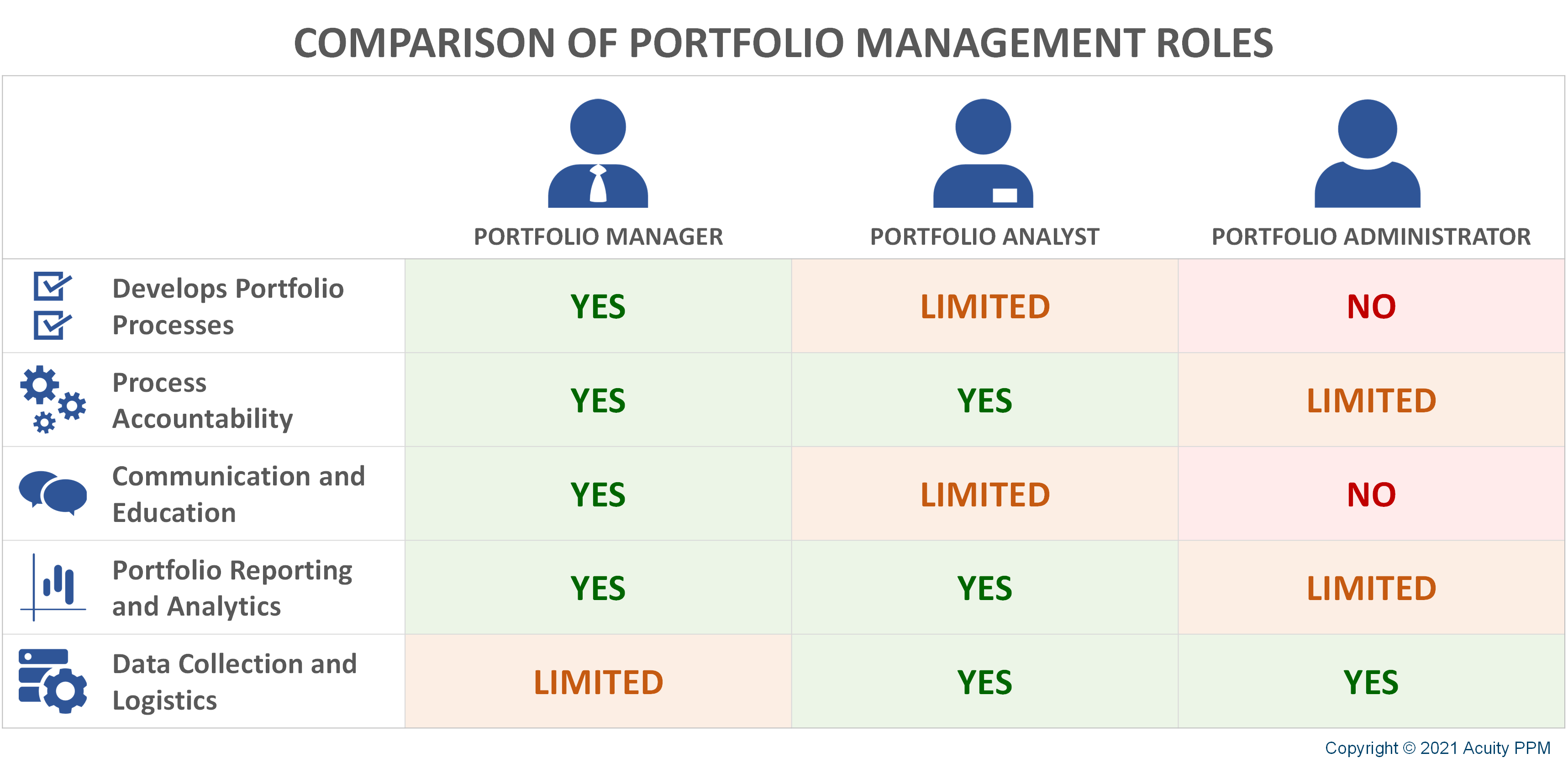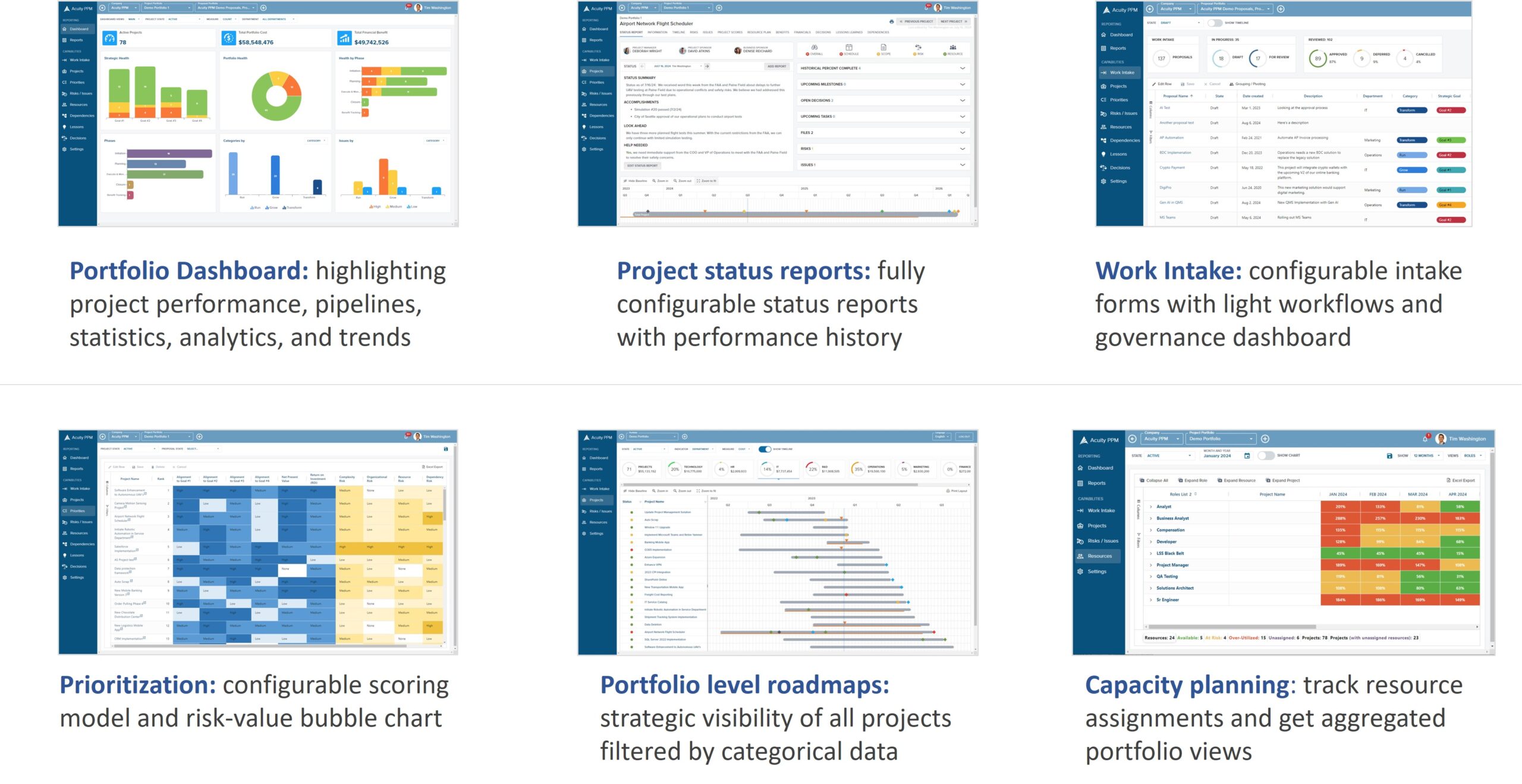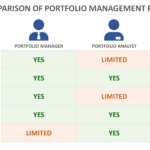What is a Project Portfolio Manager?
The Portfolio Manager role is commonly misunderstood related to project and portfolio management. In this article we will answer the questions, “what is a Project Portfolio Manager?” and “what does a Project Portfolio Manager do”? Most articles get this wrong because it is discussed from a theoretical point of view, not based on actual practice. As we will see, we cannot make the simple translation that because Project Managers manage projects, Portfolio Managers must manage portfolios – it’s not that simple. In the world of project and portfolio management, several roles are involved. The Project Manager role has been analyzed in depth, and we will briefly cover the related roles in project and program management, but in this post, we will dive into the details of what a Portfolio Manager actually does in practice and the related roles involved in project portfolio management.
Project and Program Management Roles
Before we dive into the roles of a project portfolio manager, let’s take a quick look at project and program management roles.
Project Management Related Roles
This section will focus on three project management related roles: Project Manager, Project Coordinator, and the Project Administrator.
Project Manager
A Project Manager is a project leader with a particular set of skills to lead a team to deliver a new product, service, or other outcome. Good Project Managers possess a balance of soft skills and technical skills to be able to plan, communicate, and manage work.
Project Coordinator
A Project Coordinator can be likened to a junior project manager and is often assigned more of the technical and logistical aspects of project management such as coordinating meetings, note taking, data entry, schedule updates, status tracking, etc. A Project Coordinator might lead smaller and easier projects or they may be paired with a more senior Project Manager to support on larger and more complex projects.
Project Administrator
Some organizations utilize a Project Administrator role which is very often involved with the logistics of supporting a Project Management Office (PMO). The Project Administrator may support a PMO Director to facilitate status review meetings, governance meetings, collect status for project teams, etc. A Project Administrator may help coordinate simpler and lower risk efforts.
Program Management Related Roles
This section will focus on two program management roles: the Program Manager and Program Administrator. The term ‘program’ is nebulous and can refer to a variety of things, but in this context, we understand a program to be a collection of related projects and workstreams that support a common strategic goal.
Program Manager
A Program Manager has responsibility over a set of related projects and workstreams that support a shared goal or objective. The Program Manager does not manage the details of the underlying projects and workstreams but rather helps track and coordinate these efforts to ensure a successful outcome. Program Managers focus on milestone delivery across projects, manage risks and issues that impact program objectives, and facilitate communication across related projects and impacted stakeholders in order to keep the program on track.
Program Administrator (or Program Coordinator)
A Program Administrator supports the Program Manager by helping manage program logistics (meetings, status, budget, reporting, etc.). This person could also be considered a Program Coordinator, but unlike a Project Coordinator who might lead smaller projects, a Program Coordinator does not lead smaller programs, they support the Program Manager in the overall management of a program.

VIDEO: What is a Project Portfolio Manager?
The Role of the Project Portfolio Manager
Now that we have reviewed project and program management related roles, let’s dive into the details on the role of a Project Portfolio Manager, Portfolio Analyst, and Portfolio Administrator. Please note that not all roles are needed at all organizations. The size and complexity of your portfolio along with the breadth of your processes will determine how many of each portfolio role is needed to successfully manage the project portfolio.
While project portfolio management is heavily related to projects and programs, managing a portfolio is very different than managing projects and programs. All projects and most programs have a finish date, but virtually all portfolios are managed indefinitely (M&A portfolios being an exception). The goal of portfolio management is to maximize business value, it is focused at a strategic level and helps translate strategy into execution. The function of a Portfolio Manager is very different than that of a Project or Program Manager. We will look at the direct and indirect responsibilities of the Project Portfolio Manager.
Direct Responsibilities of the Project Portfolio Manager
1) Process Owner: The first and foremost responsibility of the Project Portfolio Manager is to manage the portfolio management process, to ensure that it runs effectively and smoothly. The Project Portfolio Manager is not a direct decision maker in most cases, rather, their responsibility is on the process itself. A Project Portfolio Manager should be the subject matter expert on portfolio management and as such, is the chief architect and process owner of the portfolio management process. Based on the needs and maturity of the organization, the Project Portfolio Manager should design and build one or more of the following capabilities:
- Ideation – the process to generate and affinitize a list of new project ideas. The goal is to collect the best ideas from the organization to generate higher quality projects.
- Work Intake – refers to the steps of developing a project proposal and bringing it to the governance board for a go/no-go decision.
- Phase-Gate – a governance structure to evaluate, authorize, and monitor projects as they pass through the project lifecycle.
- Prioritization – the process of evaluating project value in order to assign resources to the most important projects and start work at the appropriate time
- Portfolio Optimization – refers to optimization techniques used to identify the optimal grouping of projects that maximize the risk-adjusted portfolio value at a given budgetary level
- Portfolio Planning – the process to optimize the sequencing and timing of approved projects based on resource constraints and project interdependencies
- Resource Capacity Planning – the process of comparing future resource utilization of project resources against available capacity to do work
- Portfolio Risk Management – assesses the risk nature of projects and manages portfolio level risks
- Portfolio Communication – processes to communicate about all aspects of project and portfolio progress
- Portfolio Reporting and Analytics – processes to analyze and report against the value and progress of the portfolio
- Portfolio Value Management – processes to evaluate, measure, and track project benefits at the portfolio level
- Project Monitoring – processes to measure and track project health and performance
- Portfolio Governance – the decision-making process to select and prioritize project work
Project Portfolio Managers should understand and analyze portfolio maturity. A portfolio management maturity assessment tool can help Project Portfolio Managers understand the level of sophistication of their organization and help them develop and implement just enough process to be successful.
Based on the processes that have been established, a Portfolio Manager also needs to hold people accountable for following the process. This is where there is both an art and a science to portfolio management. Portfolio Managers should understand organizational change management in order to help organizations adopt portfolio management processes. Developing good process is one thing, utilizing the process effectively is another. Portfolio management does not run on its own, someone needs to help project teams and senior leaders follow through on agreed upon processes. This will help improve the management of the portfolio.
2) Educator/Coach: A Portfolio Manager also needs to be an advocate and educator of portfolio management. Even though portfolio management as a strategic discipline has increased among companies over the past 20 years, many senior leaders still do not know how to manage a portfolio and make sub-optimal decisions that reduce portfolio value. A good Project Portfolio Manager will be able to educate and coach senior leaders on how to effectively manage the portfolio.
3) Communicator: as discussed in our article on portfolio communications, a Project Portfolio Manager communicates across the organization about project and portfolio value, project and portfolio risk, project and portfolio performance, project and portfolio related decisions, and the portfolio management process. Portfolio Managers need to have strong soft skills and executive presence to be able to communicate up to executive leadership and across the organization.
4) Senior Portfolio Analyst: a good Project Portfolio Manager also has a strong analytic skill set to be able to analyze project and portfolio data as well as develop reports, dashboards, and analytics to support the portfolio governance team and the Project Management Office (PMO). We will talk about the role of a Portfolio Analyst below, but a Project Portfolio Manager should have the most in-depth understanding of project and portfolio data and translate that information into actionable insights for senior leadership.
Indirect Responsibilities of the Project Portfolio Manager
A Project Portfolio Manager is directly responsible for the portfolio management process, but is indirectly responsible for portfolio performance. The direct accountability for portfolio performance falls directly on the portfolio governance team, who are the senior leaders and primary decision makers involved in portfolio management.
The Portfolio Manager is a steward of the portfolio and should bring forth recommendations to the portfolio governance team on how to improve portfolio performance, which projects to select, which projects to prioritize, and how to optimize the portfolio. However, the Project Portfolio Manager does not have direct control of the portfolio to make these decisions themselves. This is why we refer to the stewardship of portfolio performance as an indirect responsibility of the Portfolio Manager. They should be in regular communications with the PMO Director, the portfolio governance team, and other key stakeholders involved in the portfolio management process. In this way, they can provide the right information at the right time to help decision makers make better strategic decisions.
The first and foremost responsibility of the Project Portfolio Manager is to manage the portfolio management process, to ensure that it runs effectively and smoothly.
The Role of the Portfolio Analyst
A Portfolio Analyst could be considered a “junior” Portfolio Manager. The Portfolio Analyst may not be directly involved in developing new processes, implementing those processes, or holding people accountable to following those processes. However, a Portfolio Analyst may work closely with Project Managers to collect timely data or ensure that data is updated in the PPM software solution.
The Portfolio Analyst plays a big role in the day-to-day operations of portfolio management. We may say that project and portfolio data is the fuel that runs the portfolio engine. Portfolio Analysts play a big part in collecting this information from project teams and share a lot of responsibility for updating and maintaining a PPM software solution.
Portfolio Analysts are also heavily utilized to analyze project and portfolio data to develop and maintain existing PMO reports and dashboards. Even with a good portfolio management solution, a person still needs to analyze and interpret the data in order to know how and when to take action. For example, organizations that manage resource capacity often need help quality checking the data and supporting project teams to maintain the data. This information should be analyzed to support portfolio decision making on when new projects can be initiated and whether existing projects can stay on track.
Portfolio Analysts also assist with Work Intake and Phase-Gate processes to help ensure there is adequate data quality. Portfolio Analysts may help “shepherd” projects through an intake or Phase-Gate process. In larger organizations, Portfolio Analysts may be assigned to work with project teams from specific areas of the business to focus on specific projects.
The Role of the Portfolio Administrator
A Portfolio Administrator is a more entry level role in portfolio management and helps with logistical support of the portfolio process (arranging meetings, notes, etc.). A Portfolio Administrator may work with teams to collect project status, support data entry into a PPM solution, and support Work Intake or Phase-Gate processes. A Portfolio Administrator provides tactical day to day support and does not develop new portfolio processes and is not as involved in data analysis as a Portfolio Analyst is.

When Is Each Portfolio Management Role Needed?
We have discussed three key roles often involved in the portfolio management process. Let’s briefly discuss when each of these roles is needed.
- Project Portfolio Manager: the Project Portfolio Manager role is needed for organizations with a large project portfolio (typically dozens of projects, $50-100M+ of portfolio budget). This role is needed to further develop as well as implement portfolio processes.
- Project Portfolio Analyst: the Portfolio Analyst role may be needed either to support a Portfolio Manager in a very large project portfolio, or can oversee a small to medium sized portfolio without a dedicated Project Portfolio Manager. A strong Portfolio Analyst may be able to develop some new portfolio processes but likely lacks the skills to fully implement the processes. Organizations with an existing PMO but are implementing the fundamentals of portfolio management (i.e. portfolio tracking) may only need a Portfolio Analyst at this point.
- Project Portfolio Administrator: the Portfolio Administrator is likely needed for medium to large sized portfolios to support a Portfolio Manager or possibly a Portfolio Analyst. Very large organizations may benefit from both a Portfolio Analyst and a Portfolio Administrator, but most organizations likely need one or the other. The difference is in how much involvement and expertise is needed in order to effectively manage the portfolio process.
Portfolio Director vs. PMO Director
A Portfolio Director is a senior manager with direct oversight over the portfolio management team. This role may be needed when there are two or more portfolio management roles as part of a dedicated portfolio management team. A Portfolio Director (or Vice President) is the primary liaison to other senior leaders and may have some decision-making authority for certain portfolio decisions. In this case, the Portfolio Director becomes the ultimate process owner for portfolio management.
A PMO Director is the manager over a project management office (PMO). If a dedicated portfolio management team has been set up with a Portfolio Director, then the PMO Director’s primary responsibility is for managing the Project Managers (and related project-based roles). Otherwise, portfolio management responsibilities often fall within the PMO and the PMO Director oversees both project and portfolio management and is the process owner for both.
Common Portfolio Manager Fallacies
We will conclude this post by covering a couple of myths related to the Project Portfolio Manager role.
Myth #1: “Project Portfolio Managers are responsible for the selection, prioritization and alignment of projects and programs with an organization’s strategy”. This is almost always false. A Project Portfolio Manager almost never has unilateral decision-making authority in relation to project selection, prioritization, and strategic alignment. This is the responsibility of the portfolio governance team. This thought comes in error due to thinking that because Project Managers manage projects, Portfolio Managers must manage portfolios. This is true only to an extent – as we discussed earlier, Project Portfolio Managers are primarily responsible for the portfolio management processes, but the portfolio governance team (composed of senior leaders) is directly responsible for selecting, prioritizing, and aligning projects and programs to an organization’s strategy.
It would be very rare for any single Project Portfolio Manager to control that much decision-making authority over the project portfolio. In some cases, there may be a single Executive who has ultimate decision making authority for the portfolio, but they would not be considered a “Portfolio Manager” as they very likely do not have the time to carry out all the responsibilities outlined above for a true Project Portfolio Manager.
Myth #2: In order to become a portfolio manager, one must first be a Project Manager and/or a Program Manager. Partially false. Due to the nature of projects being heavily involved with portfolio management, it seems logical that senior Project Managers could become Portfolio Managers, but this is not always the case. Portfolio management requires a different skill set from project management. Portfolio Analysts do not need project management experience in order to be successful Portfolio Analysts. These Portfolio Analysts often progress to become Project Portfolio Managers. A strong background in project management is valuable for any Portfolio Manager, but it is not a prerequisite.
Acuity PPM Project Portfolio Management Software – Designed for Portfolio Managers
Acuity PPM is an excellent lightweight project portfolio management solution that replaces spreadsheets. Acuity PPM helps you track project performance, report project and portfolio status to senior leaders, manage and prioritize incoming project requests, visualize strategic roadmaps, allocate resources and manage resource capacity. All of this helps enable strategic agility in a changing environment.

Tim is a project and portfolio management consultant with over 15 years of experience working with the Fortune 500. He is an expert in maturity-based PPM and helps PMO Leaders build and improve their PMO to unlock more value for their company. He is one of the original PfMP’s (Portfolio Management Professionals) and a public speaker at business conferences and PMI events.
[activecampaign form=3]
What is the difference between a Project Manager and a Project Coordinator?

A Project Manager is a project leader with a particular set of skills to lead a team to deliver a new product, service, or other outcome. Good Project Managers possess a balance of soft skills and technical skills to be able to plan, communicate, and manage work. A Project Coordinator can be likened to a junior project manager and is often assigned more of the technical and logistical aspects of project management such as coordinating meetings, note taking, data entry, schedule updates, status tracking, etc. A Project Coordinator might lead smaller and easier projects or they may be paired with a more senior Project Manager to support on larger and more complex projects.
What does a Project Portfolio Manager do?

The first and foremost responsibility of the Project Portfolio Manager is to manage the portfolio management process, to ensure that it runs effectively and smoothly. The Project Portfolio Manager is not a direct decision maker in most cases, rather, their responsibility is on the process itself. A Project Portfolio Manager should be the subject matter expert on portfolio management and as such, is the chief architect and process owner of the portfolio management process. Based on the needs and maturity of the organization, the Project Portfolio Manager should design and build one or more of the following capabilities: work intake, prioritization, Phase-Gate, portfolio tracking, and resource capacity planning.
What is the difference between a Portfolio Manager and Portfolio Analyst?

A Project Portfolio Manager is responsible for developing and implementing project portfolio management processes. They represent the status of the portfolio at portfolio governance team meetings. A Portfolio Manager is an advocate of the portfolio process and helps educate the organization on portfolio management. A Portfolio Analyst could be considered a “junior” Portfolio Manager. The Portfolio Analyst may not be directly involved in developing new processes, implementing those processes, or holding people accountable to following those processes. However, a Portfolio Analyst may work closely with Project Managers to collect timely data or ensure that data is updated in the PPM solution. The Portfolio Analyst plays a big role in the day-to-day operations of portfolio management.
What is the difference between a Portfolio Director and a PMO Director?

A Portfolio Director is a senior manager with direct oversight over the portfolio management team. A Portfolio Director is the primary liaison to other senior leaders and may have some decision-making authority for certain portfolio decisions. In this case, the Portfolio Director becomes the ultimate process owner for portfolio management. A PMO Director is the manager over a project management office (PMO). If a dedicated portfolio management team has been set up with a Portfolio Director, then the PMO Director’s primary responsibility is for managing the Project Managers (and related project-based roles). Otherwise, portfolio management responsibilities often fall within the PMO and the PMO Director oversees both project and portfolio management and is the process owner for both.
Never miss an Acuity PPM article
Don't take our word, listen to what others are saying:
"I find value in all of your articles."
"Your articles are interesting and I am sharing them with my team who have limited project knowledge. They are very useful."


